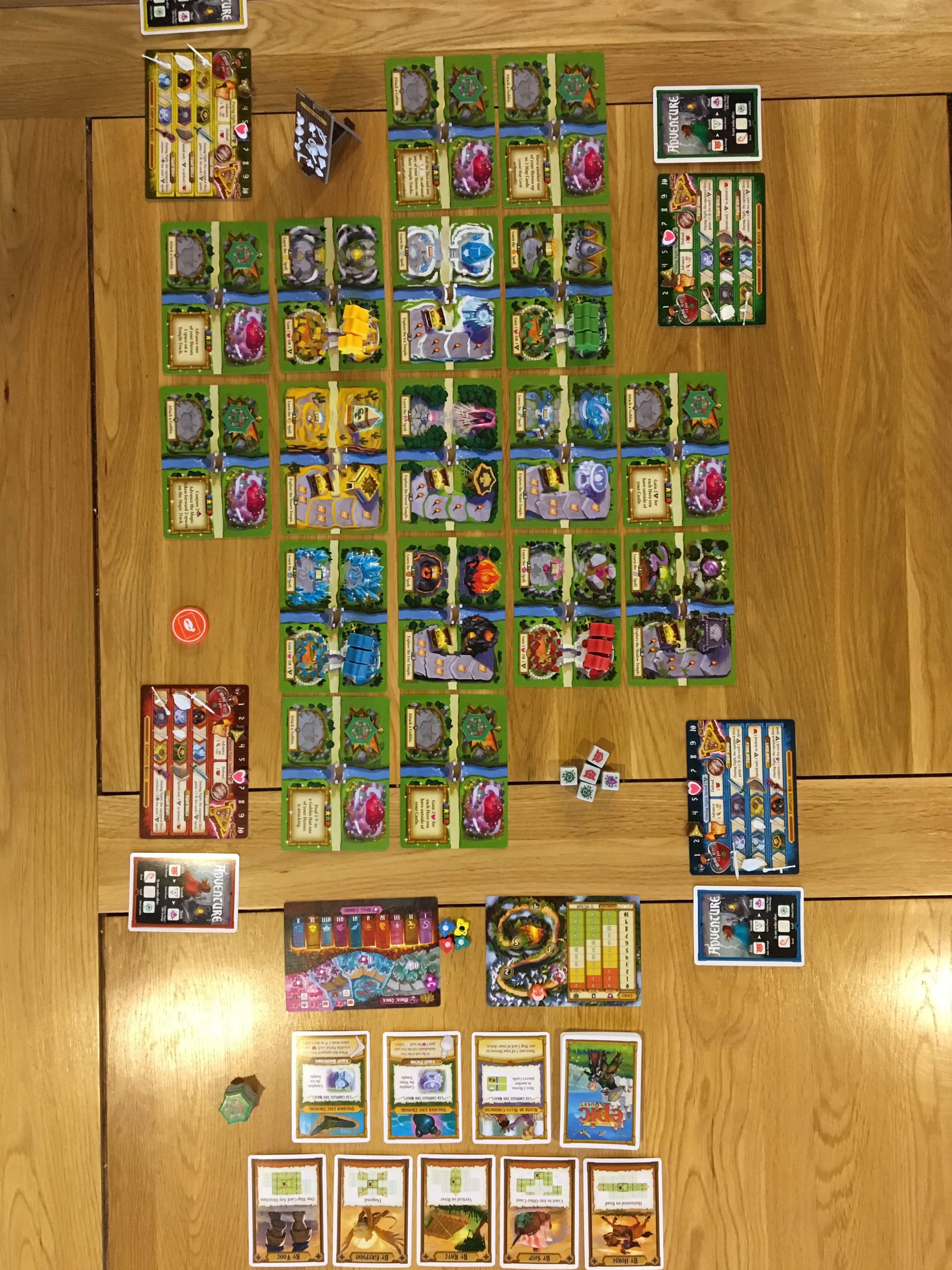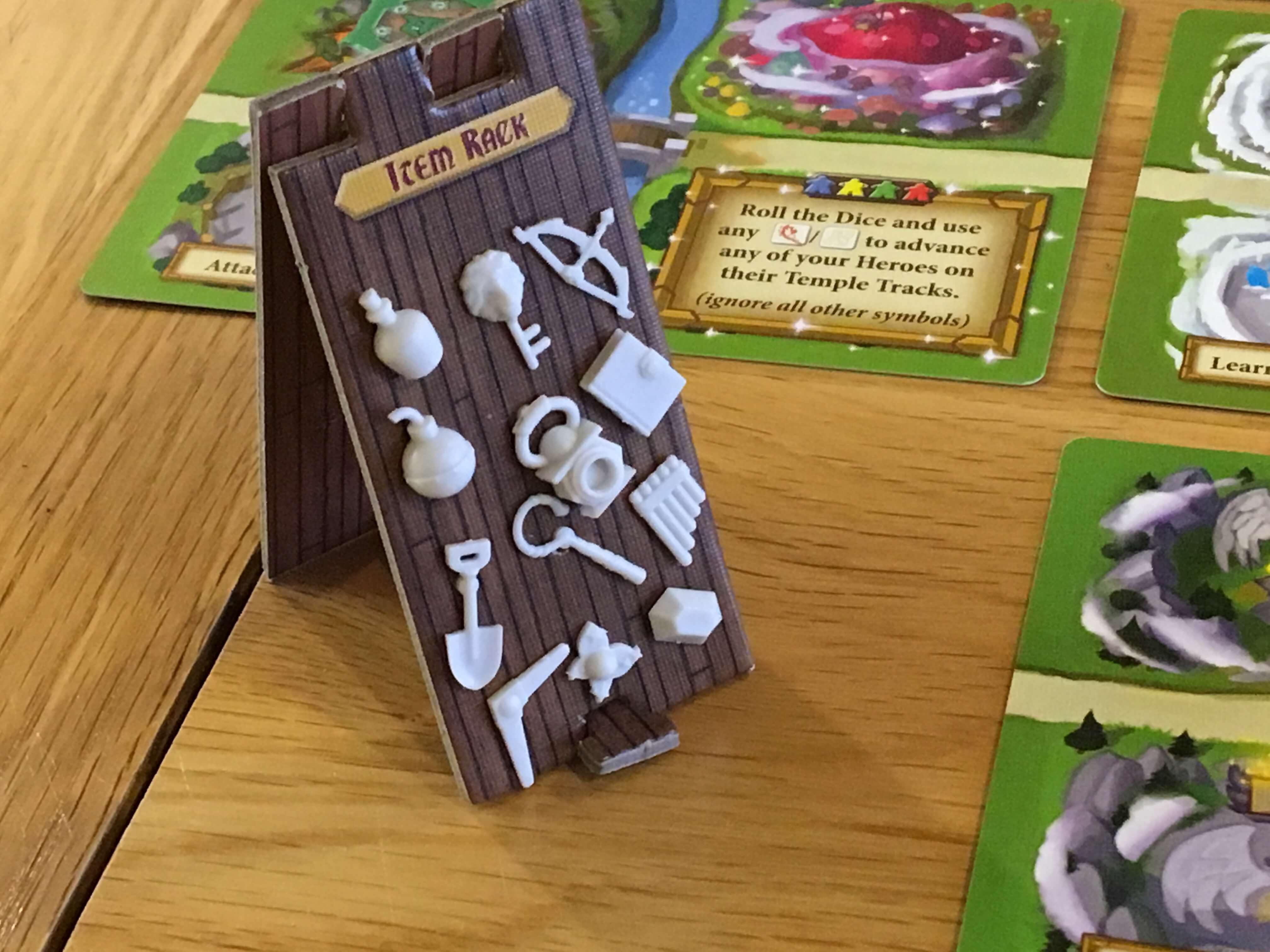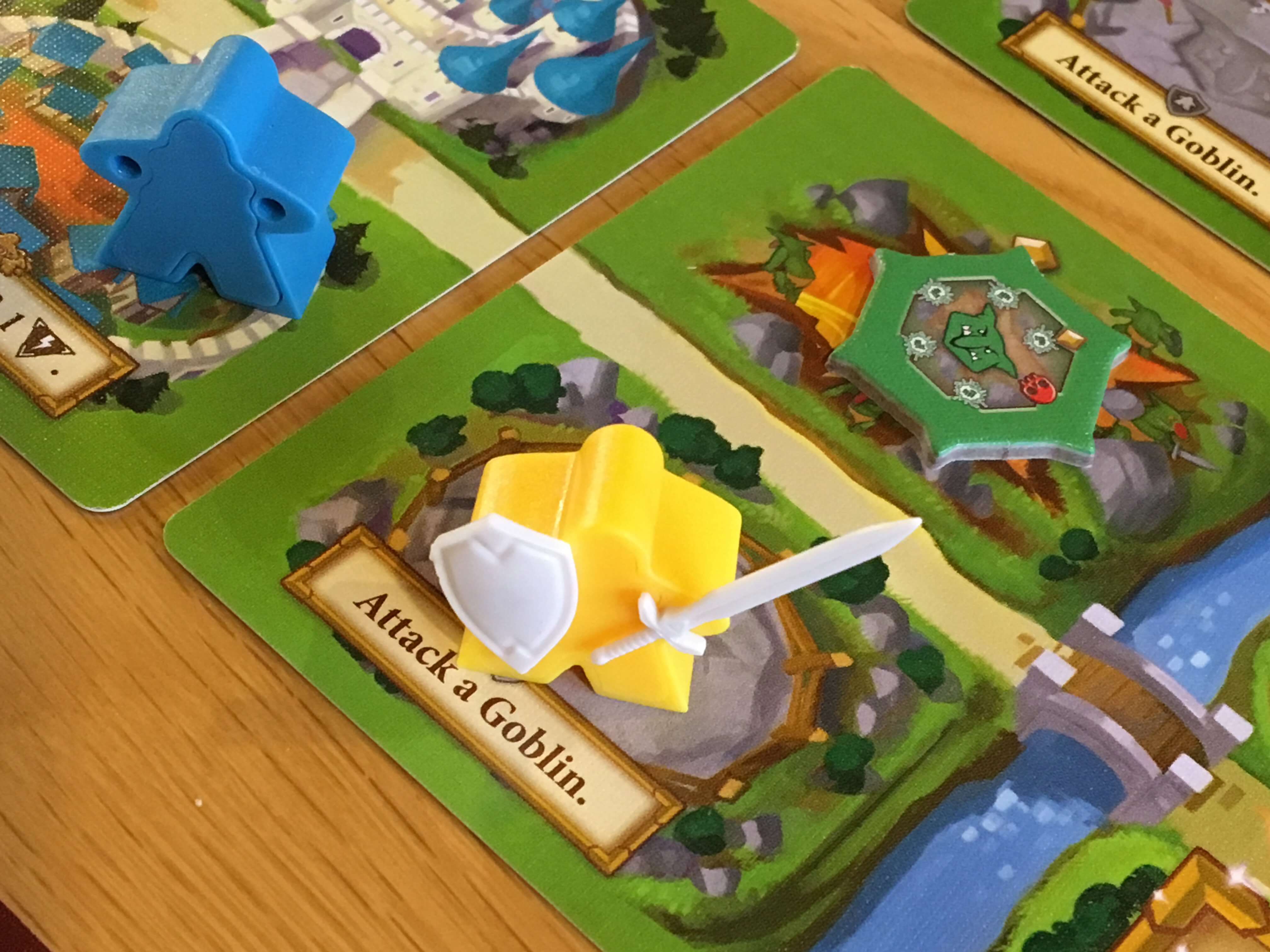Tiny Epic Quest review — Little legend
Have you ever wished you could experience the strategic depth of a heavier game, but without needing to store a huge box and handle a lengthy and complex explanation every time you need to introduce a new player? Perhaps you need to consider diving into Tiny Epic Quest, which comes in a box that is perhaps four by six inches in size, but contains a game that expands across an entire table and delivers an immersive experience.

Overview
Tiny Epic Quest is both the name of the game and a very good literal description of what you can expect from it. One to four players can enjoy it and it takes between thirty and sixty minutes to play, yet during that time, goblins will be fought, spells will be cast, treasures will be revealed and quests will be resolved.
Each player controls three elven meeples, each of which comes with the unique (as far as I know) feature of being able to hold a weapon or item in each hand — literally — by clipping tiny swords, wands and other items to them. The playing area is made up from a partially randomised configuration of cards which take up a surprising amount of space. Movement is based on the use of five different cards (representing walking, flying, riding etc.), each of which allows movement in accordance with a specific pattern.
Tiny Epic Quest’s gameplay is split into two phases. During the day, players take their movement actions (with the ability to follow on from another player’s move) and set themselves up to score as highly as possible. This is when players prepare to gather quests and spells or ready themselves to fight. At night, players can either rest or push their luck and roll some dice (into the box lid, which also provides a bit of reference data for possible outcomes) to resolve the various activities set up during the day.
The objective is to amass the most points (as a product of undertaking the heroic deeds I’ve been hinting at), but there’s also a racing element — the game ends when either the last goblin is defeated or as the result of closing the portal that unleashed them upon the world. As a result, players who plan lots and act little might find themselves unable to convert their efforts into points.

Components
Big, as they say, is beautiful, but it seems that tiny can also be very attractive as well — such is the fantastic build quality and attention to detail that has been lavished upon Tiny Epic Quest. The small box is eye-catchingly bright and bold, with artwork unmistakable and instantly appealing to the wandering eye. Leave this game on your shelf and regardless of how small it might be, people in your gaming group will immediately be drawn towards it.
Once it’s opened up, Tiny Epic Quest is only more impressive is on the inside. As I mentioned, the inside of the lid acts as a dice box that includes a visual aid to demonstrate the potential outcomes and sets the tone for what else you’ll find. The deck of location cards is larger than you might think and when laid out, it takes up a fair bit of space. Each card is as attractive as the box and when everything is laid out on the table, it’s an impressive sight that pops with colour and tiny details. If anything, the tableau these cards create when laid out reminds me of the world map in Zelda: Link’s Awakening (which I don’t think is accidental, for the record).
That isn’t the half of it though: there are twelve little meeples in four colours along with a range of weapons and items to attach to them. Among these, each player receives swords, shields and staffs, whilst on a shared storage rack, you’ll find a wide range of items that must be found by exploring the game world, including lanterns, bows and much more. Now, there is a slight downside here — attaching these items is a massive pain in the backside and frankly, far too fiddly for my giant hands. It’s cool, yes, but arguably a bit of style over substance.
There’s also a set of custom dice, a tonne of player boards (including a shared scoreboard and a magic track) and a load of wooden tokens to go with them. There are tokens for the goblins that use an innovation ‘dial’ design to track their health. Several decks of cards deal with quests and items. Then there are adventure cards and movement cards. Everything in Tiny Epic Quest is beautifully designed and when it is all laid out on the table, you will be amazed that it all fits in the tiny box.

Turn structure
Turns in Tiny Epic Quest do take some explaining, thanks mainly to how much you can achieve per turn and the fact that there are two distinct (and mechanically different) phases, each of which is repeated five times (tracked by a specific board). During the day phase, the first player selects one of the five movement cards (foot, horse, ship, raft or gryphon), which lets them move one meeple in accordance with what that card allows. For example, moving by foot lets that meeple move one space in any direction, whilst the raft lets it move up or down a river.
Each map card has two spaces on it (one on each side) but the player can only occupy one side with a single meeple at any time — and it’s not possible to move between the sides. Once the first player has moved, everyone else may use the same movement type to move if they wish, then the second player chooses a movement type and repeats the process. One movement type will remain unused in each round, so regardless of the number of players, four movement choices are made.
The reason for movement is to position meeples on the locations you’d like them to occupy during the night phase, which lets you do things that score points. Landing on a temple, for example, might let you complete it during the night. Landing on a goblin might mean you defeat it, whilst landing on a magical totem might let you roll dice to increase the magic track, which may in turn grant access to spells above your current spell level.

Once the four movement cards have been resolved and the day phase ends, the night phase begins. The first player either rests (effectively passing, returning their meeples to their castle and sitting out the remainder of the phase) or rolls the dice. Each die face does a different thing, with goblins wounding the player, power symbols providing one power and magic increasing the magic track. What’s interesting is that the first player only suffers or benefits from one of each symbol, whilst any excess symbols of the same kind pass around the table. For example, if they roll three goblin faces, the first, second and third player all take damage.
There are also scrolls and torches to roll, which can be used to help meeples progress through a dungeon or temple. Again, these rolls benefit all players, but each adventure location has different requirements, so they may benefit different players at different times. Resolving some quests provides a legendary item, resolves a quest or lets the players progress their personal weapon track upwards to obtain one of the three basic weapons.
The dice rolling passes from player to player, so players can resolve (potentially) all three of the things their meeples might be sitting on. The push-your-luck element is all about when to rest — if your health is exhausted at any point during the night phase, anything you’ve achieved earlier in the phase is forfeit. The decision to stick with it is easy when you have nothing to lose, but as soon as you’ve defeated a goblin, for example, you might think twice about sticking with a temple that you’re halfway through — especially if you have three other players between you and your next chance to rest.
Game experience
I find myself playing games that are billed as small, portable or otherwise suitable for travel often, but it’s quite rare that I find them to be as deep, immersive or engaging as their big-box equivalents. When I actually do travel, I’d rather take a deck builder or complex card game (even if it means stripping it of its coffin-sized box) to ensure I get my fix of heavier gameplay. Since I received Tiny Epic Quest, that problem has more or less been eradicated.
The game features at least moderate variability thanks to the way the board is randomised and how cards are used to deliver quests and drive the action. That is good, because whilst I think there’s lots to do in the game — from combat to exploration — it isn’t as long as most larger games are, which is more than likely by design, given the portable aspiration.
I’ve referred to the depth of gameplay quite a bit in this review and in my description of Tiny Epic Quest, but perhaps the right word to use for it is actually ‘breadth’. That’s mostly because its main way of entertaining the players is to offer them lots and lots of things to do, most of which can be completed quickly. You’ll want to focus on achieving at least one or two (ideally three) point-scoring opportunities each turn and the game rewards players for achieving a variety of tasks. There are negative points for ignoring any quests, goblins or magic altogether and goblins (for example) offer more points in isolation than any other form of point scoring.
There’s a lot to take in when it comes to learning and teaching Tiny Epic Quest and I’d say that it is perhaps a bit challenging to get into — it takes at least two or three games to become fully proficient with how some of the features work (for example, the fact that meeples are withdrawn when you rest and all progress towards uncompleted tasks is lost). That said, it’s a game that you only really learn by playing it – a brief overview followed by a learning game was much more effective in my experience than a long, detailed overview.

Conclusion
The slightly unusual structure of Tiny Epic Quest makes it a little tough to teach, but it also makes it fun and exciting to play. The day phase is logical and pretty much free of luck (although it doesn’t always go how you’d like) whilst the night phase is all about pushing your luck in a controlled manner. Sure, bad luck can affect an individual player more than others, but because any die faces above the first pass to the next player(s), it takes monumental bad luck to always be the one person taking damage.
The component quality is undoubtedly part of the appeal and there are few games at this price point or of this scale that are as beautiful, or that expand to present such a comprehensive and broad experience (both physically and mechanically). As I said before, the gameplay is relatively shallow, with any activity needing to be resolved within a single round of night and day, but there’s a lot to do and as the game progresses, items and powers increase how efficient the players are at getting things done, which adds a real sense of reward to proceedings.
Tiny Epic Quest is a game that supports any number of players equally well and thanks to its small nature, it makes an excellent travelling companion. Ironically it is actually too large when set up for some situations (trains, for example) but that’s hardly a criticism. I also really struggled connecting those tiny weapons onto the patented ITEMeeples that hold them, though again, I don’t really hold that against the game as such.
This is a game that I like a lot — I really enjoy being able to play a game that offers such chunky decisions in a portable format. My colleagues and friends have all enjoyed it as well and despite some challenges in teaching it, I’ve found people mostly willing to come back for more. As such, I recommend Tiny Epic Quest as a very interesting game for anyone who loves a deeper game but perhaps doesn’t have the chance to store one, or who travels often and wants to play solo or with friends when in hotels, for example.
A copy of Tiny Epic Quest was provided for review purposes. You can find out more about Tiny Epic Quest on the website of publisher Gamelyn Games.

Comments are closed.